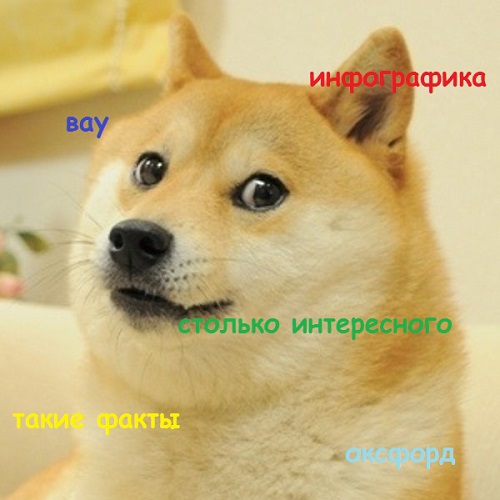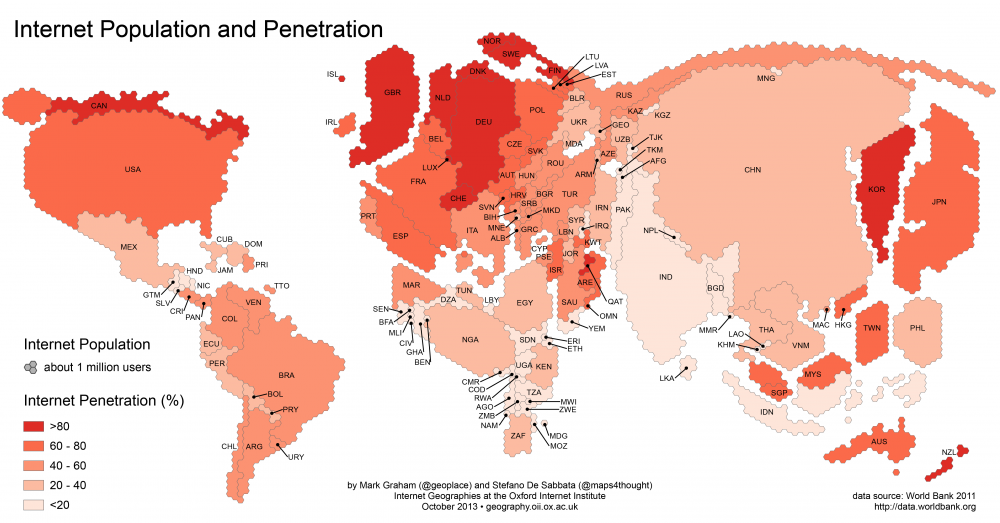Global Internet penetration, where Thor is most used and why Russia is so poor: some curious infographics about the global network
On the website of the Oxford Internet Institute you can find a solid collection of data visualizations about the Internet , compiled by the Institute over the past three years.

For this post I chose:
')
- Internet penetration statistics by country,
- global statistics on the use of Torah,
- statistics on the activity of programmers (based on the distribution of users and commits of Githab),
- diagram of Internet trunk cables,
- statistics of requests and deletions of data on the Internet,
- views of Internet users on different countries.
All of the following pictures are clickable.
The size of each country on the map corresponds to the size of its Internet population in millions of people, and the color reflects the depth of Internet penetration:

a source
The largest Internet “population”, more than half a billion people - in China. Next on the list are the USA, India and Japan. At the same time, China, India and Japan together have more users than the United States and all of Europe. In total, Asia is home to 42% of Internet users. However, the United States, with its number of network users, still has room to grow in terms of reaching a larger percentage of the population. India has even greater potential with its Internet penetration depth of less than 20%. So far, the majority of countries with Internet coverage of more than 80% of the population (except for four - Canada, New Zealand, Qatar and South Korea) are in Europe.
From 2008 to 2011, almost all countries in North Africa, as well as Kenya, Nigeria and South Africa, doubled the number of Internet users.
However, only a third of the world's population has access to the Internet.
A good addition to the previous map is a study showing the number of Internet users using the "Torus". To be honest, I don’t have the slightest idea what Italy is doing among the leaders:

a source
Despite the fame and popularity of the Torah, it is used by only 750 thousand people a day. For comparison, this is less than the daily attendance of Habr. More than half of the users of Thor come from Europe, in particular 76 thousand from Italy. Another 126 thousand users come to Thor from the USA per day. The data used for infographics is presented by Thor himself .
The map is based on GitHub site statistics for 2013. On the left hemisphere - the number of users from different countries. Right around the circle - the number of users by country, left - the number of commits (changes) per country. On the map itself - the depth of penetration of the githab users relative to the total number of Internet-based active population:

a source
The number of Github users last year amounted to 3.5 million people, with the number of users from individual countries strictly correlated with the degree of Internet penetration into the country. In general, by the number of developers from different countries using the Github, one can judge how the main centers of the knowledge economy are distributed throughout the world.
A great way to understand how fragile the Internet can be, despite its power:

a source
For example, Russia, according to this scheme, is connected to the global network with only three cables: one from the US, going through Japan, the second from Finland, and one South European, passing through the territory of Georgia, with which the Russian authorities have very difficult relations. By the way, the diagram still shows signs of “enemies of the Internet”: Russia is easy to find from the full collection of collected icons: three out of three. By the way, Iran has only two. In the USA, what is even more interesting is also two.
At the same time, the United States has the most diversified network of cables connecting them to the rest of the world. In the second and third places are the United Kingdom and Senegal, which has distinguished itself due to the fact that many Atlantic cables pass through it. In a city-wide study, Egyptian Alexandria is the world's largest hub. Singapore and Al Fujairah (United Arab Emirates) immediately follow.
The importance of being in the center as large as possible in size is twofold: on the one hand, the Internet in such places is traditionally faster and cheaper. On the other hand, it opens up great opportunities for controlling traffic. According to Reporters Without Borders in their study “ Enemies of the Internet 2014 ”, several British communications companies at once provided access to their radio intelligence infrastructure of the United Kingdom .
The scheme is based on the cable map from the site cablemap.info
Here we have collected data on the number of requests from authorities and courts in different countries to remove content from Google based on reports from Google itself, published every six months. The report is interactive, to play with it - click the picture:

It is especially curious to watch, moving the slider over the years, how some countries “darken”, obviously entering the taste of inquiries and deletions.
And in the end - almost amusing, but suggestive statistics: what do Internet users think about different countries of the world ? Collected on the basis of Google hints to questions like "Why% country% so ...":

[ suggest andorro news ]

For this post I chose:
')
- Internet penetration statistics by country,
- global statistics on the use of Torah,
- statistics on the activity of programmers (based on the distribution of users and commits of Githab),
- diagram of Internet trunk cables,
- statistics of requests and deletions of data on the Internet,
- views of Internet users on different countries.
All of the following pictures are clickable.
Internet population
The size of each country on the map corresponds to the size of its Internet population in millions of people, and the color reflects the depth of Internet penetration:

a source
The largest Internet “population”, more than half a billion people - in China. Next on the list are the USA, India and Japan. At the same time, China, India and Japan together have more users than the United States and all of Europe. In total, Asia is home to 42% of Internet users. However, the United States, with its number of network users, still has room to grow in terms of reaching a larger percentage of the population. India has even greater potential with its Internet penetration depth of less than 20%. So far, the majority of countries with Internet coverage of more than 80% of the population (except for four - Canada, New Zealand, Qatar and South Korea) are in Europe.
From 2008 to 2011, almost all countries in North Africa, as well as Kenya, Nigeria and South Africa, doubled the number of Internet users.
However, only a third of the world's population has access to the Internet.
Share anonymous users
A good addition to the previous map is a study showing the number of Internet users using the "Torus". To be honest, I don’t have the slightest idea what Italy is doing among the leaders:

a source
Despite the fame and popularity of the Torah, it is used by only 750 thousand people a day. For comparison, this is less than the daily attendance of Habr. More than half of the users of Thor come from Europe, in particular 76 thousand from Italy. Another 126 thousand users come to Thor from the USA per day. The data used for infographics is presented by Thor himself .
Developer interaction map
The map is based on GitHub site statistics for 2013. On the left hemisphere - the number of users from different countries. Right around the circle - the number of users by country, left - the number of commits (changes) per country. On the map itself - the depth of penetration of the githab users relative to the total number of Internet-based active population:

a source
The number of Github users last year amounted to 3.5 million people, with the number of users from individual countries strictly correlated with the degree of Internet penetration into the country. In general, by the number of developers from different countries using the Github, one can judge how the main centers of the knowledge economy are distributed throughout the world.
Fiber backbone layout
A great way to understand how fragile the Internet can be, despite its power:

a source
For example, Russia, according to this scheme, is connected to the global network with only three cables: one from the US, going through Japan, the second from Finland, and one South European, passing through the territory of Georgia, with which the Russian authorities have very difficult relations. By the way, the diagram still shows signs of “enemies of the Internet”: Russia is easy to find from the full collection of collected icons: three out of three. By the way, Iran has only two. In the USA, what is even more interesting is also two.
At the same time, the United States has the most diversified network of cables connecting them to the rest of the world. In the second and third places are the United Kingdom and Senegal, which has distinguished itself due to the fact that many Atlantic cables pass through it. In a city-wide study, Egyptian Alexandria is the world's largest hub. Singapore and Al Fujairah (United Arab Emirates) immediately follow.
The importance of being in the center as large as possible in size is twofold: on the one hand, the Internet in such places is traditionally faster and cheaper. On the other hand, it opens up great opportunities for controlling traffic. According to Reporters Without Borders in their study “ Enemies of the Internet 2014 ”, several British communications companies at once provided access to their radio intelligence infrastructure of the United Kingdom .
The scheme is based on the cable map from the site cablemap.info
Statistics of requests and deletions of data on the Internet
Here we have collected data on the number of requests from authorities and courts in different countries to remove content from Google based on reports from Google itself, published every six months. The report is interactive, to play with it - click the picture:

It is especially curious to watch, moving the slider over the years, how some countries “darken”, obviously entering the taste of inquiries and deletions.
Princes and paupers from an Internet perspective
And in the end - almost amusing, but suggestive statistics: what do Internet users think about different countries of the world ? Collected on the basis of Google hints to questions like "Why% country% so ...":
Why% country% so [rich / poor]

- Why% country% such [cold / hot]
- Why% country% such [darling / cheap]
- Why% country% so [good at sports]
- Why% country% is so [happy / powerful]
- Why% country% is so [popular / awesome]
- Why% country% is so [important / special]
- Why% country% is so [big / small]
[ suggest andorro news ]
Source: https://habr.com/ru/post/238387/
All Articles